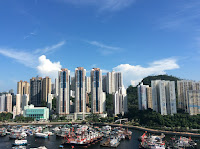鴨脷洲在60年代以前還沒被填海之前,與其說像鴨的舌頭,更像一個無頭的母鴨,有腿、有尾,還連帶着幾隻鴨蛋,長長的脖子正是現在的鴨脷洲邨(西邨)和海怡半島的海字及怡字樓盤的位置;美字和御字樓盤處以前是海灣,叫䃟石灣。
 |
| 鴨脷洲,1920s |
In a previous article in May, my blog about possible ancient Chinese names for Hong Kong Island, figuratively speaking implied the island looking more like a horny dog, who is in such a heat that he was humping the “duck” next to him. The shape of Ap Lei Chau, the little island next to Hong Hong Island, is like a duck without a head, before the western side was reclaimed in 1960s and turned into a housing complex today; not only clearly visible are body, legs and tail, she also just laid eggs (before these tiny islands were reclaimed too). The “duck” was so embarrassed by this absurd act, she buried her head deep into the sea. The little dog (Snoopy Rock on top of Ling Kok Mountain, Lamma Island) felt the same way, kept barking; unfortunately it was a bit too far, so the situation persists for millions of years until today.








